|
The
|
|||||||||||||||||||||||||
THE BURGENLAND BUNCH NEWS - No. 244 June 30, 2014, © 2014 by The Burgenland Bunch All rights reserved. Permission to copy excerpts granted if credit is provided. Editor: Thomas Steichen (email: tj.steichen@comcast.net) Archives at: BB Newsletter Index Our 18th Year. The Burgenland Bunch Newsletter is issued monthly online. It was founded by Gerald Berghold (who retired Summer 2008 and died in August 2008). |
|||||||||||||||||||||||||
Current Status Of The BB: * Members: 2259 * Surname Entries: 7449 * Query Board Entries: 5308 * Staff Members: 17 |
|||||||||||||||||||||||||
This newsletter concerns: 1) THE PRESIDENT'S CORNER 2) EARLY MEMORIES OF BURGENLAND, 1956–1957 (by Andrew Burghardt) 3) LOIPERSDORF (OR NOT)? 4) HOLDEN, SÖLLNER AND BAUER: PEASANT CLASSES 5) MY QUEST FOR JUSTICE - CONCLUSION (by Ilse Nusbaum) 6) HISTORICAL BB NEWSLETTER ARTICLES: - BURGENLAND MILITARY GENEALOGY (Joe Gilly and Gerry Berghold) 7) ETHNIC EVENTS 8) BURGENLAND EMIGRANT OBITUARIES (courtesy of Bob Strauch) |
|||||||||||||||||||||||||
1) THE PRESIDENT'S CORNER (by Tom Steichen)  Concerning
this newsletter, after the bits and pieces here in my "Corner," we continue with
a reprint (by permission of the BG) of an article written in 2000 by
Andrew Burghardt called Early Memories of Burgenland, 1956–1957. I think
of this as a post WW-II / Russian Occupation companion to C.A. Macartney's 1937
(pre-war) piece, Burgenland, that we presented in newsletters
241 and 242. Macartney gives us the before; Burghardt the immediate after... bookends, if you
will. Concerning
this newsletter, after the bits and pieces here in my "Corner," we continue with
a reprint (by permission of the BG) of an article written in 2000 by
Andrew Burghardt called Early Memories of Burgenland, 1956–1957. I think
of this as a post WW-II / Russian Occupation companion to C.A. Macartney's 1937
(pre-war) piece, Burgenland, that we presented in newsletters
241 and 242. Macartney gives us the before; Burghardt the immediate after... bookends, if you
will.Article 3, Loipersdorf (or Not)?, deals with the problem of duplicate (or similar) village names and introduces a new online resource, the Catholic church books of Styria (Steiermark). In Article 4, we once again attack the meanings of certain class titles for non-noble medieval peasants, Holden, Söllner and Bauer. Article 5 concludes a five-year effort for Ilse Nusbaum in her Quest for Justice for her father. This is the third and final article about her effort to obtain a posthumous Ph.D. for her father. The remaining articles are our standard sections: Historical Newsletter Articles, and the Ethnic Events and Emigrant Obituaries sections.
|
|||||||||||||||||||||||||
2) EARLY MEMORIES OF BURGENLAND, 1956–1957 (by Andrew Burghardt) [from the Burgenländische Gemeinschaft Newsletters Nr.363 and Nr.364, 2000; reprinted by permission] Andrew Burghardt first came to Burgenland as a young scientist in 1957 to conduct scientific research on this area. In subsequent years, meanwhile appointed university professor, he continued his research, which culminated in the publication of the seminal book entitled "Borderland" in 1963. In recognition of his outstanding work, he received the Land Burgenland Honor Award in 1995. I first saw Burgenland in September 1956. I had selected it to be the subject of my doctoral thesis at the University of Wisconsin. Mary and I, newly-married in August, drove to Vienna from Paris where we had bought a tiny Renault car. A small grant of $3.000.- was all we had to buy the car and to live on in Austria. I had known some Burgenländers in New York; I took pictures of them and brought them with me to help introduce myself to their relatives. Before sailing to Europe I had also been able to meet and speak to Dr. Kurt Schuschnigg (the Chancellor of Austria before the Hitler take-over), Dr. Ernst Winter (the son of the pre-war vice-mayor of Vienna, married to a von Trapp), and the son of Count Teleki. My first view of Burgenland was on a field trip of geographers held as part of the 100th anniversary celebration of the Viennese Geographical Society. We were driven to the Parndorfer Heide, and the Professor told us that this was, at least physically, not a part of Austria, that it had a strong Hungarian character. We were impressed by the dry windy flatness and the seeming emptiness of the area. From other Viennese acquaintances and professors, I gained their impressions of Austria's newest province. Most of their perceptions were uncomplimentary. It was said to be poor, rundown, dusty. There were flocks of geese everywhere. There were no conveniences for travelers. There was a uniform opinion that the roads were terrible. One person referred to the area as "Austria's Balkans," another as a "gypsy land." Although one did call the area "charming," it seemed clear to me that most Viennese did not care for the land, did not consider it to be truly Austrian. (Interestingly, some felt a touch of guilt for Austria having taken this territory from its old partner in the Monarchy). The shortcomings were always blamed on the Hungarians, who were said to have neglected the area and repressed its people. (Of course, I knew that what is now Burgenland was composed of little more than the Western fringes of three different countries before 1919 and, as such, could hardly have expected much development). In late September, Mary and I made our first real reconnaissance by driving from Neusiedl to Güssing. We found that most of the roads were actually in good shape. In fact, when I came to look at the borders closely, I saw that the roads between Burgenland and Niederösterreich were always excellent on the Burgenland side and often terrible on the N.Ö. side! We did see geese, but they hardly swarmed over the roads and fields. Places to stay were certainly few; when we stopped overnight in Lockenhaus, we were bitten by fleas in our bed! While I was reading all the old newspapers in the Landesbibliothek in Eisenstadt, I stayed in two Gasthäuser in Eisenstadt. I remember my room in the Eder as being so cold that I went to bed with my overcoat on and slowly undressed under the covers. It was amazing that the provincial capital did not have one good hotel. (However, I could not have afforded to stay in one if there had been one.) Later, especially in March and April, I made numerous trips into and through Burgenland, examining every portion of the province, and being fascinated by the valleys of the south. The countryside was charming, and most of the pretty villages were "Strassendörfer", with the whitewashed houses lined up on either side of the street. Usually each house was at right angles to the road, and along one side was a narrow hof [courtyard]. The kitchen with the oven was half way back, the bedroom usually behind it, and further back were the tools, wood, and animals. Because of the danger of fire, very few houses still had straw roofs, and those were mostly in the south. In some of the villages, the shutters or the whole houses were painted; I remember Luising and Kemeten as being very bright and colorful. 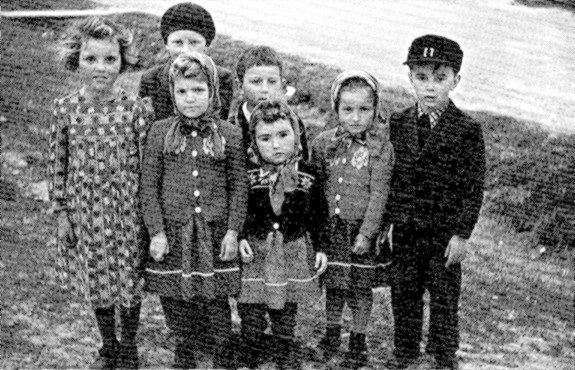 Hagensdorf children. Whereas the married women dress completely in black or other somber colors, the girls are dressed in vivid colors, with much red. The boy in the rear wears his beret in Hungarian fashion. Since tourists are nonexistent in southern Burgenland and cameras are few, the children do not know how to pose for a picture. 25 March 1957 Although I was able to get a very cute picture of children in Hagensdorf, I did not notice many children. It was clear that the birth rate had fallen, probably because so many of the young married people had emigrated. One school in Stegersbach had had 65 pupils in 1921 but had only 26 in 1957; the official minimum to keep a school open was 20. Family groupings were strong, and it was common for all members of the extended family to vote the same, and to keep marriages within the group. Religion was strongly felt, both for and against. Burgenland possessed several fine pilgrimage churches. Perhaps the most notable were those in Frauenkirchen and Loretto in the north and Gaas in the south. I happened to be east of Güssing on March 25, the feast of the Annunciation. I was stopped by several bone-weary old women who were walking home after their pilgrimage to Maria am Weinberg, overlooking Gaas. I was able to stuff them into my tiny car and drive them home to Hagensdorf and Luising. In contrast to this piety, was the distrust of religion going to church, as usually did their families as well. After all, there had been a virtual civil war fought between the Socialists and the Christliche in 1933-34. Many villages had both Catholic and Protestant (evangelisch) churches; their members tended to keep to themselves and even to attend their own taverns. There were stories of street fights between the boys attending the schools. The Protestant pastors could not forget that, at least in Austria, they did not enjoy religious freedom until after 1786. Perhaps as a response to the end of that long-ago persecution, their churches were often built with very high towers. Except for a few factories and small mines, the local economy was based almost entirely on agriculture. Most of the produce was for home consumption, to feed the people and the animals. Wine was the king of the cash crops, but wine was profitable in only a few locales: along south-facing slopes, such as the edge of the Parndorfer Platte (Gols), the flanks of the Leithagebirge (Eisenstadt), the Rustergebirge (Rust-Mörbisch-Oggau), along the Wulka, and on the Eisenberg in the south; also on the sun-soaked plains east of the Neusiedler See (Illmitz etc.). It was possible to have one's own bottle filled with the "house wine." I recall one day when Walter Dujmovits informed me that a vintner in Eisenstadt had some of his good wine for sale. I took an empty bottle and had it filled; it was indeed good. For the great majority of the peasant farmers, the sale of animals and sometimes milk was the principal local source of money. For the most part, the animals were not driven to market; rather the Viennese buyers drove their trucks right into the villages to pick up the animals, milk or eggs. Rye and wheat were the predominant grains. There was very little maize (corn). (In contrast, in 1989 I noticed that here had been an enormous expansion of maize and vineyards.) By North American standards, the land holdings were very small. The usual figure I heard was about 6 hectares, 15 acres. This was felt to be sufficient. One farmer claimed that he could make a good living from his 4 hectares, 10 acres, of rich Lafnitz valley bottomland. (There were unfortunate owners of "dwarf-holdings" who tried to get by with even less than 2 hectares.) Despite what looked like land poverty to me, many of the peasants still believed that they were better off than the "hungry" burgers in Vienna. (Vienna had been besieged only 11 years before.) A visit to a home usually ended with me taking home a gift of eggs. I don't remember seeing many tractors or other machinery; almost every peasant still had his horse and/or oxen. The working of the land required much hand labor, and the older peasants were heavily dependent on having members of the family to help. One older man told me how he had pleaded tearfully with his son not to leave for America, but the young man left anyhow; the old couple did not know how they would manage without him. I heard too of young men who were willing to stay on the land, but could not find a girl willing to marry them and become a peasant wife. Being the only driver on a road did not mean that I could avoid the traffic cops. One day, with no other car in sight, I parked on the road for a good look at the stone quarry in St. Margarethen. Sure enough a policeman came along, announced to me that I could not park there, wrote me a ticket, and asked for immediate payment. So, I paid. When I got back to Eisenstadt, I told my friends at the Landesbibliothek, Karl Semmelweiss and Dr. Sinowatz (later, 1983-86, Chancellor of Austria) of the ticket. They were angry and told me that if I hadn't already paid, they would have "fixed" the matter. But, of course I had paid; what else can a foreigner do? 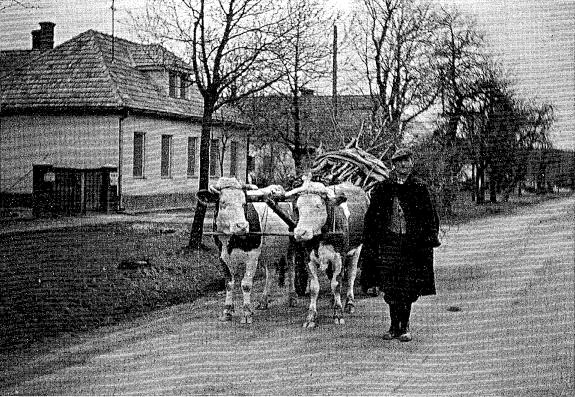 Moschendorf. Farmer bringing home twigs and branches for heat. Note that he too wears the typical boots and apron. 1957 For me, the peasant working costume was picturesque, even if very dark. They all wore black boots (Csizmen, Stiefeln), a necessity in the muddy fields. All, men and women, wore dark aprons, and the women wore kerchiefs to keep the dust out of their hair. On Sundays or on pilgrimage, the older women still wore the completely-black dresses, so common in eastern Europe. Although I found the working outfits interesting, I gathered that the local farmers did not. One couple refused to let me take their picture (for relatives in New York) as they were. I had to return the next day, when I found them dressed up in "Western" clothes: the man in a jacket and tie. I was disappointed but took the picture. I saw Trachten [traditional folk/national costumes] worn only once and that was at a Croatian festival in Frankenau in 1961. Once I was shown some of the other folk costumes hanging up in a museum closet, but I never saw them worn otherwise. There were no dirndls or any wide, bright Hungarian skirts. Most of the money that came into Burgenland did not come from agriculture. Burgenland was uniquely a land of commuters, of Pendler. Hordes of men and young women left the province to find paying jobs elsewhere. Initially there was the mass migration to America; this was partly due to the loss of jobs in Hungarian border towns such as Szentgotthárd, and Ödenburg. Although emigration did continue, many families now found their work in Vienna, where they toiled in construction and other non-office jobs. (The Viennese men all wanted to work in offices and carry brief cases.) The fortunate families who lived in the north commuted on a weekly basis, that is, the men would spend the week crowded into small rooms in Vienna and spend their weekends at home. Families did not move to Vienna, as one might expect them to. This was because they had their houses, their friends and relatives in the villages, whereas the cost of housing for families was, to them, exorbitant in Vienna. As the villages became further and further away from Vienna, the time away from home increased; to two weeks or even a month between visits. Needless to say, this put a tremendous strain on the families. While the men were away, the women, older people, and young children worked the land. Finally, there were the men in the forest-encircled villages of the south, who might work as far away as Switzerland; many of these became seasonal commuters. In some of those villages, it was said that for many months one could find very few men at home. Most of the Pendler were men, but some young women moved also to become store clerks in Vienna. There was almost no tourism in Burgenland at the time. Podersdorf, which has the only true beach on the Neusiedler See, had only one Gasthaus. A few people came to look at the birds, mostly storks, in Rust and in the reeds around the See. Eisenstadt was just beginning to "cash in" on Haydn, and Mörbisch was presenting Hungarian-style operettas during the summer. Almost no visitors, except relatives, went south of Forchtenstein. The one attraction in the south was Bad Tatzmannsdorf, and that was poorly developed at the time. Except for Forchtenstein and Eisenstadt, most of the castles were ignored or unknown; many of them were still in the ruined state in which the Russians had left them. 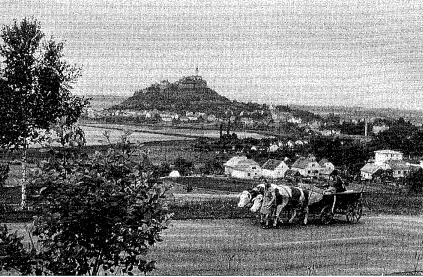 On the road to Güssing, 1957 It's fair to say that most Burgenländers did not recognize how attractive their province could be. Several times I was asked, why was I studying Burgenland? Why not Tirol? They could not grasp that a foreigner could be interested. Some were suspicious; after all, the Russians were next door in Hungary. More than once I was asked to show my passport. One family thought that I must be engaged to marry the daughter of a Burgenländer in New York and was there to meet the relatives. My car had a French license plate and I recall one young woman saying in surprise, "Ein Französer!" Automobiles were rare; I never had to worry about traffic problems once I had left Vienna. This was an advantage for me, because it made it possible for me to pick up tired walkers and ask them my questions about Burgenland in a friendly way. I even picked up a border guard that way. Once when I was driving an old lady home as it was beginning to get dark, and we were right along the (mined) Hungarian boundary, she offered me a swig of some slivovits she had. When I refused for fear of running off the road, she insisted that this was a really good bottle. When I still refused, with thanks, she thrust the bottle into my mouth and poured the fire water in. I gulped, but managed to keep the car on the road; ——yes, the slivovits was very good. 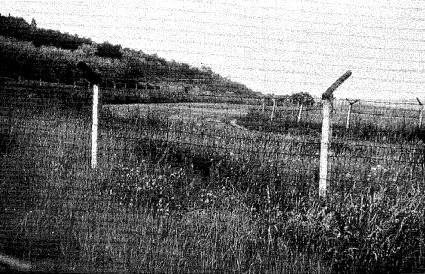 The Iron Curtain at Mogersdorf, 1961 Cameras were also almost non-existent in Burgenland. People, especially children, were not used to having pictures taken. Several times I took pictures of family members and promised to send them prints later. One peasant in Moschendorf was so pleased with the picture I sent of him with his ox-cart, that he wrote to tell me that he was going to have it enlarged—something he was probable able to do. 1956 was only eleven years since the end of the war, and only one year since the Russians had pulled out. Memories were strong because the young Burgenland men had mostly been drafted into the infantry. One home I visited had a little votive candle burning under the picture of their son, who had been lost in Russia. I remember Walter taking me for a walk in Eisenhüttl and pointing out how many men had been lost from each house we passed. Small villages had long lists of names on their war memorials. In one family, the mother died while the father was in the army. Her sister took over the care of the children during the final siege. When the father returned from the Russian prisoner of war camp, he married the brave sister-in-law. The Hungarian Revolution of 1956, while allowing Strem valley neighbors to get together again, also raised fears that the Russians, chasing the refugees, would return into Burgenland. Some of the older people tied that fear in with the belief that the Hungarians were certain to try to regain Burgenland. One old lady in Edelstal was sure that they would return. Naturally, I was interested in the "minorities." One would have expected the Magyars to make the most demands, but they were quiet. They recognized that they were very few, since the lawyers, teachers, etc. had almost all left for Hungary. They had been the target of all the charges about repression made by the German super-nationalists, and were a bit cowed. Besides, the two Magyar centers, Oberwart und Oberpullendorf, were governmental centers and had to do their business in German. But there was a trace of bitterness underneath. One Magyar priest commented, "Under 400 years of supposed 'repression' by the Magyars, the Croats kept their language, music, dances, costumes, and now after 30 years of Austrian "freedom" they have lost much of it." The Croats were greater in number and had been even more numerous in the past. They were split in two by location and politics. The Croats in the north were mostly industrial workers and, therefore, had been in favor of becoming part of Austria; they were Socialists. In contrast, the Croats in Oberpullendorf Bezirk and further south, had poorer ties to Viennese jobs and were mostly supporters of the People's Party (ÖVP). They had been mostly in favor of remaining in Hungary and, after coming to Austria with their leader Karall, had formed a strong cultural association, making demand for language rights and teaching. These Croats were somewhat in favor of cultural ties with Yugoslavia but were fearful of being forced either to migrate to Croatia or to have their areas annexed to Croatia (Yugoslavia). Marshall Tito, ruler of Yugoslavia, had supposedly asked for this area from the Western Allies. There was the fear, too, that Tito would try to have the 1919 idea of a Slavic corridor joining Yugoslavia and Czechoslovakia established. The Croats were strongly against communism but had been able, because of their Slavic language, to get along better with the Russian soldiers than the German could. During the ten-year occupation, Russian was a required language in the schools. Religious groups were not included under "minorities," but I found the Lutherans to be in the trickiest situation. They believed in the unity of the German people and so were for the move to Austria, even though Hungary had been more tolerant than Austria had been. They were looking past Austria to an union with Germany. Unfortunately, this led them to support Hitler... within Austria, they felt that they could not support the pre-war Christian Party or the post-war People's Party since, in their minds, both were connected to the Catholic Church. Economically, they did not want to support the Socialists nor, religiously, the ÖVP. They became, therefore, the supporters of Third Parties. So I found Burgenland: a charming, almost unknown province, rarely visited by other Austrians or anyone else (except relatives). A poor land of hospitable people, where almost all the palaces or other buildings had been stripped bare by the Russians only a year before. It was still an agricultural landscape, with oxen and horses, but with the young people increasingly seeking paying jobs in Vienna or elsewhere. My mother had on her kitchen wall a reproduction of a famous painting by Brueghel of peasants having their lunch in the fields. Brueghel painted that picture over 400 years ago, yet that is how I first saw much of Burgenland. I thank God that I could see it that way before the great changes of the following 40 years. To be able to see it when I was almost the only visitor in a land that was as foreign as Asia to most of the people of Europe in America. |
|||||||||||||||||||||||||
3) LOIPERSDORF (OR NOT)? Back in April, the BB received a New Member Information Form that was both baffling (in a number of ways) and ultimately informative: Subject: BB New Member Information Sender_Name: Chris Jacobson From_Email_Address: [redacted] Town_State_Country: [redacted] Surname_1: LENZ Village_1: Loipersdorf Settled_1: Milwaukee, WI text: Mary & Berta Lenz, from Loipersdorf, immigrated to Milwaukee. Mary in 1929, Berta in 1937. Mary is my grandmother. The first way it was baffling was that I did not receive it, even though my email address was listed as an intended recipient of the message [FYI: our BB membership forms are designed to gather the needed information and then send automatic emails with the information (as per the example above) to a list of BB staff so they can respond to and/or process the information... my email address is on that list]. I became aware of the original message some six days later, but only after Margaret Kaiser had responded to Chris and Chris had responded back (via "reply all") to her... I received Chris' second response, even though I did not receive Margaret's intervening message! By examining my email program lists, I've confirmed that I did not accidentally delete it or mis-file it and that I received numerous emails on the dates (4 days apart) that Chris and Margaret sent the messages I did not receive. So the problem was not me or a general email failure. But clearly, I failed to receive at least two messages. So let this serve as a gentle warning: if I don't respond to you when you think I should, it may be that your message ended up in the great bit-bucket in the sky (is NSA behind this? ;~); send me another message gently asking if I received your first missive; I'll try to at least confirm I did (or did not). However, I will note that there are times I do get overwhelmed with messages... or buried by personal projects... or I get just plain lazy... and I do fail to respond timely to messages I receive; you'll just have to forgive me when that is the case. Let's get back to Chris' message... as I said, I became aware of it because Margaret Kaiser had responded to Chris, who in turn responded back, and it was this third message I received. Margaret had suggested that Chris provide more information, as Berta's passenger manifest indicated she was born in 1910, a year where scanned civil records were available. Chris responded with appropriate details: Berta (Bertha to us) was born 10 Jan 1910, and Mary was born 4 Oct 1897. They had the same father, but different mothers. Mary had 2 older brothers, then after her mother died and her father remarried, Bertha, Anthony & Richard were born. The father's name was Karl Lenz & Mary's mother was Juliana Dear. I don't know Bertha's mother's name. Given these specific birthdates, it was easy to jump into the Loipersdorf (Lipótfalva) civil records, held in Markt Allhau (Alhó) in district Oberwart, and look for them... which I did... and I did not find them! I wrote to Chris: Hi Chris, I looked through the Loipersdorf (im Burgenland) civil records for both ladies and found neither… were they actually born there? There is a Loipersdorf bei Fürstenfeld in Styria… it is only ~15 miles from the other Loipersdorf… could they be from there? Unfortunately, those records are not online. I also found both ladies on ship manifests… and both were living in Vienna prior to going to the US. Both listed father Karl, one in “Loidersdorf, Burgenland” (an apparent misspelling) and the other saying just “Loipersdorf”. This prompted Fritz Königshofer to write (with some great news
[edited for length]): Chris, I followed the message trail with Tom and Margaret, and
wished to contribute. The big news that needs to be spread out is that the Roman Catholic
records of Steiermark (Styria) have been digitized and were made available for on-line access on
the Internet last December. This is a test version which requires some patience. On the other
hand, the records are the original matrikels, not the duplicates, which were written since 1835.
The original Styrian matrikels, most of the time, include indices which greatly facilitate
finding your ancestors and their first degree relatives (siblings, children and parents,
sometimes even grandparents). |
|||||||||||||||||||||||||
4) HOLDEN, SÖLLNER AND BAUER: PEASANT CLASSES Last month, as part of the Historical BB Newsletter Article (from 15 Mar 1998, NL #31A) entitled "Karen Barnard Sends Us a List of the Inhabitants [of Mariasdorf]," I included an editorial insert that spoke of certain class titles for non-noble medieval peasants. The article, itself, contained a listing of homeowners in Mariasdorf that was centered on the 1857-1874 era and supplemented with both the 1770 and 1988 ownership information. My editorial insert was written because various individuals in the list were given status or class titles that are likely not well known to us today. One title, holte, seemed to resist meaningful interpretation, so I asked you readers to reply if you had a suggestion for what the term meant. In the meanwhile, though, Fritz Königshofer and I have been noodling on this issue, seeking to better understand the distinctions among the classes. Before I go into what we discovered, I will repeat my editorial insert [slightly edited for the new context here] so you can recall what I wrote: Söllner was a person with a house and garden but no (or little) farmland, who usually worked as a hired-hand, businessman or craftsman. This term was used in both 1857 and 1770 [in the Mariasdorf list] to indicate the property owner's status. Those craftsman specifically identified by occupation (like the shoemakers in [Mariasdorf] houses 12 and 13) would also be in the Söllner class. Kleinhäusler is a related term and is also used in the list, but only in the 1857 entries; it may imply a (semi-)retired person/couple or widow/widower, again with house and garden but no farmland. Regardless, it is a subset of Söllner. At the top of non-noble medieval peasant village society were the farmers (Bauer). A certain amount of farmland (enough to support a family and the required tenths to the manor and church) was required before you were considered a Bauer. Some lesser nobles also were in this class. In addition, the term holte is used to describe some individuals in the 1770 entries. Initially, we thought this was an odd spelling of holde or hulde, German terms related to the status of Holden. Fritz Königshofer suggested that, since zsellér is the Hungarian form of Söllner, perhaps holte was a Hungarian form of holde. The problem with this proposal is that Holden were the poorest of the poor in feudal society, having neither house nor land, so it makes no sense that six people in this list would be designated holte=Holden, given they are in a list of property owners. (The term I've seen in village houselists for apparent Holden is Inwohner, which is Austrian dialect for lodger/renter.) However, hólte (note the accent) can translate to 'dead' in Hungarian, a status that works in the property owners list... but why would one obscure Hungarian word be used in 1988 in an otherwise German text, especially when the original 1770 list likely would have been written in Latin, not Hungarian? We are baffled! So, if you have a suggestion as to what the term holte meant in this list, please write and share your thought.]
So, here we have a word, Söldner, that had one meaning, 'a soldier's pay,' that evolved into another meaning, 'payment for work,' and then morphed into another spelling, Söllner, that became a class of peasant and, in the process, lost both its original meaning and spelling.
To give some perspective about the amount of land allocated to the various
classes, I'll provide material from a (German-language)
webpage by Konrad
Unger, wherein Konrad quotes Father Graisy's text about Wallern, in particular, about peasantry
classes and property ownership in Wallern in the year 1865 (note that this is well after 1848,
the year when peasantry was officially terminated).
There is also a (German-language)
webpage about the village of Sopronbánfalva (Wandorf) that gives additional
perspective on these issues, though it speaks to the situation before and at the time
of the Urbarial Patent of 1767. Wandorf is just west of Sopron (and initially was
intended to be part of Burgenland in 1921), so its situation was likely quite similar to other
villages in West Hungary that did become Burgenland.
Note that this is somewhat less than in Wallern in 1865, where the acres for a half-farmer
were: 0.545 for house, 21.87 of field, and 3.78 of meadow, for a total of 26.19 acres (the big
difference being in the field allocation). Do note, however, that field allocations depended on
the fertility of the local land, so this may merely imply that Wandorf had better land than
Wallern. |
|||||||||||||||||||||||||
5) MY QUEST FOR JUSTICE - CONCLUSION (by Ilse Nusbaum) This is the story of a dissertation that grew into a monument. The story’s beginning appeared in the October 2011 BB Newsletter [and a follow-up appeared in November 2012]. My father, Karl Löwy, a Ph.D. candidate at the Wirtschafts-Universität (WU) [Vienna University of Business and Economics], completed his coursework and submitted his dissertation on January 21, 1938. The title was Viticulture in Austria: Economic-Geographic Studies. The only thing standing between him and his doctorate was his defense of the dissertation. He expected to receive his degree in June. Instead, he was one of about 150 students and staff expelled from the University (then called the University of World Trade) for "racial" or political reasons (almost all because they were Jewish) immediately after Austria’s annexation into Germany and one of two doctoral candidates denied the right to defend their dissertations. Many of the expelled students were murdered in the Holocaust. 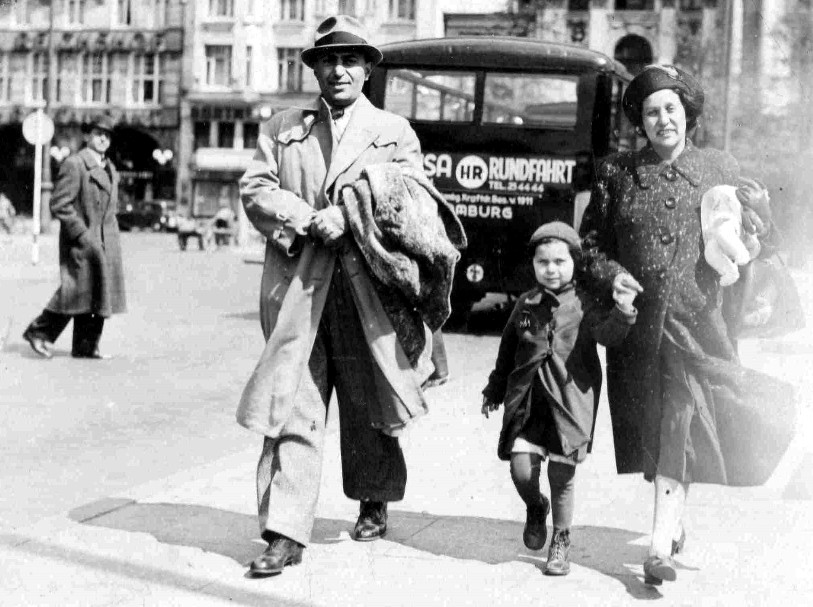 We
were lucky. My parents were prescient. On February 12, 1938, the chancellor of Austria met with
Hitler in Germany. On Monday, February 14, 1938, my mother went to the American consulate in
Vienna to apply for visas to America for herself, my father, and me. March 13, 1938, Hitler
entered Vienna to crowds waving swastika flags. The next day, my father lost his family home in
Eisenstadt, his job as a teacher at the School of Economics there, and his opportunity to get
his degree. Our visas to America arrived in April. Since we had visas and a sponsor, my father’s
sister in Detroit, we sailed to America in May. We
were lucky. My parents were prescient. On February 12, 1938, the chancellor of Austria met with
Hitler in Germany. On Monday, February 14, 1938, my mother went to the American consulate in
Vienna to apply for visas to America for herself, my father, and me. March 13, 1938, Hitler
entered Vienna to crowds waving swastika flags. The next day, my father lost his family home in
Eisenstadt, his job as a teacher at the School of Economics there, and his opportunity to get
his degree. Our visas to America arrived in April. Since we had visas and a sponsor, my father’s
sister in Detroit, we sailed to America in May.He started over, earned a second Master’s degree in Economics at Wayne University in Detroit, and had a successful career as a CPA, but he often spoke about his dissertation. I assumed it no longer existed; the Germans burned books written by Jewish authors. My father was more optimistic. My parents planned to return to Vienna in the autumn of 1970 to find out what had become of it. Airline tickets were purchased and travel plans made. It was not destined to be. He had a fatal heart attack shortly before they were scheduled to leave. That is far from the end of the story, however. Despite my theory that the dissertation was long gone into ashes, the Internet provided an outlet for discovery. As soon as I joined the Burgenland Bunch, I began Googling my father’s name. Nothing. Then, on the anniversary of Kristallnacht in 2009, up popped his dissertation in a wine article bibliography. I learned that it was archived in the WU library. I contacted the University librarian, requesting a scan of the title page; she mailed me an entire copy. I had never intended to return to Austria, but now I had a mission in mind, a quest to right a long-ago wrong. My daughter and I flew to Vienna on September 11, 2011. I phoned the WU librarian to tell her our plans. She invited us to the library to see the dissertation. When we walked into the library, the dissertation lay on the table. I opened the book, and my quest for justice began. The Swastika The photocopy I have at home does not show the back of the title page. If I had not looked at the original typescript, I would not know that it is ink-stamped with a swastika. The swastika seal that identified it as University property outraged me. I was determined not to let that be the last word. My initial request was a posthumous doctorate for my father. It was denied. He hadn’t successfully defended his dissertation. I pointed out that he hadn’t been allowed to take the exam because he was Jewish. No one at the University seemed to believe me until the historians got into the act. They discovered a document that clearly states, “not permitted to take the exam because he is Jewish.”  That
piece of paper made the difference. No more denial, but a posthumous degree was impossible.
Instead, the University would put up a plaque on a wall in its soon-to-be abandoned campus. From
this small beginning grew an entire research project. The historians found 120 to 150 students
who had been expelled immediately after the Anschluss. That
piece of paper made the difference. No more denial, but a posthumous degree was impossible.
Instead, the University would put up a plaque on a wall in its soon-to-be abandoned campus. From
this small beginning grew an entire research project. The historians found 120 to 150 students
who had been expelled immediately after the Anschluss. Since the University was moving to a new campus near the Prater, the opportunity arose to erect a monument with names. A Memory Book with the names and fates of the expelled students was published online (see here for the Löwy entry). On VE Day, May 8, 2014, the university dedicated the monument that began with a modest request for a posthumous degree. Ed Note: Ilse fails to mention in her article (so I will) that she is credited in the project brochure for being the inspiration for the research project and its companion monument and that she was a guest of honor at the unveiling and dedication of the monument. Further, she had a full week of touring and family history in Austria to accompany the dedication ceremony. I will summarize her busy trip (with her brother and her daughter) and then end with her comment in reply when I asked about the emotions of the week: On the Saturday before the dedication, Ilse and her family went to Burgenland with Gert Tschoegl, whose email in 2009 prompted the search for her father's dissertation. He escorted them to Eisenstadt, where they stayed mostly inside the Esterházy palace to escape the rain. On Sunday, the WU librarian, Regina Zodl, and historian, Werner Sulzgruber, took them on an outing, first to Markt Piesting, where her mother's family once lived. They met the mayor and then toured the house once owned by her maternal grandparents. From there, they went to Wiener Neustadt to see the hospital where Ilse was born, and on to Baden, where her great-grandfather once owned a vineyard. Ilse notes that, "Like all good genealogists, I went to the Baden cemetery and looked at my grandfather's gravestone." 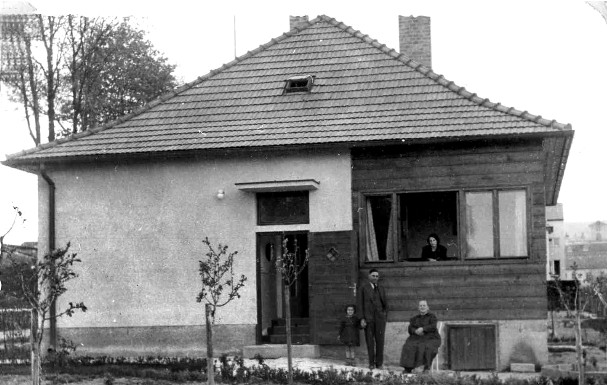 Then
they returned to Eisenstadt, to visit the house where Ilse and family once lived, a house
designed in part by her mother. They also went to the Jewish Museum and the Wolf Winery, where
her paternal grandfather had worked. Then
they returned to Eisenstadt, to visit the house where Ilse and family once lived, a house
designed in part by her mother. They also went to the Jewish Museum and the Wolf Winery, where
her paternal grandfather had worked. On Monday they met the University rector and the historians who had worked on the project. On Tuesday it was a day trip to Prague and on Wednesday another to Budapest. Thursday was the day of the dedication celebration (it was very moving, she says) and on Friday they flew home. Quite a week! Ilse wrote: "It seems strange to me, and humbling, that I was the person who set this in motion with my persistence. They say that they are ashamed that it took a scholar's daughter to make them realize what their university had done to ruin the lives of its own students." |
|||||||||||||||||||||||||
6) HISTORICAL BB NEWSLETTER ARTICLES Editor: This is part of our series designed to recycle interesting articles from the BB Newsletters of 10 years ago. However, Gerry did not publish a June 2004 Newsletter, so I went back to the early days of the BB, to Newsletter No. 38B (30 Jun 1998). Therein, I found an article concerning the military units that Burgenland men served in. This is an area I know little about, so I personally found it interesting reading; I hope you do too! THE BURGENLAND BUNCH NEWS No. 38B June 30, 1998 BURGENLAND MILITARY GENEALOGY (Joe Gilly and Gerry Berghold - copy of a pre-BB-newsletter email exchange) Joe Gilly writes: My great grandfather Michael Feiertag's marriage record (3 Feb 1876) lists his occupation as "Honved-Soldat, 76 Reg. aus Neustift." I can't find a translation for Honved in the Hungarian dictionary. Do you know the meaning? Gerry answers: "Honvéd" is Hungarian and translates to Hungarian soldier. With various endings, it can be "Honvédelem" (home defense) or "Honvédezred" (regiment of Hungarian soldiers) or "Honvédhuszár" (Hungarian cavalry) or "Honvédseg" (Hungarian territorial army). The "e" would have a diacritical mark ' over it. Your g-grandfather would thus be a "soldier of the Hungarian Army - 76th Regiment - Headquartered at Neustift." During WW-I, most southern Burgenländers served in either KuK Infanterie - Regiment Nr 83 (Steinamanger-Szombathely) or Honvéd Huszár Regt. Nr 18 (Ödenburg-Sopron). This would translate to Imperial and Royal Infantry Regiment 83 headquartered at Szombathely and Hungarian Light Cavalry Regiment Number 18 - Sopron. When either of these two regiments saw combat, the resultant casualties could be devastating to any particular village, as the men from a village tended to be together in the same platoon or company. During WW-II, I understand that most draftees would have served in a Styrian regiment, since the Burgenland was attached to Styria by the Nazis. I imagine, however, that many volunteers were in the German Luftwaffe, Wafen SS or even the Viennese Hoch und Deutschmeister Regiment. Two of my Gilly cousins (Helena Gilly's father and uncle) died in WW-II, one in Finland and one in Russia. I don't know their unit, although another Gilly served 5 years in the German Signal Corps. The military organizations changed over the years, of course, hence your 76th Regt. During the Napoleonic Wars (period 1790-1814), the men living in our area could have served in any one of dozens of regiments named after the aristocrat who raised or led them or the place where they were raised like: Line Infantry Graf Sam. Gyuli - 1802 Esterházy, Line Infantry Furst Anton Esterházy, Eisenburger Hussars, etc. My source (Austrian-Hungarian Army of the Napoleonic Wars - Osprey, London, 1986) lists 64 Line Infantry Regiments, of which at least 15 were Hungarian. There were at least that many cavalry regiments (Cuirassiers, Dragoons, Light & Heavy, Hussars, Uhlans). There were also "Grenz (border) Regiments" of irregular infantry and horse. Prior to that time, military history gets pretty fuzzy as to organizations, with many mercenary groups from everywhere plus local defense settlers, of which Croatian colonists were prominent. Joe writes: Why would the Swedes, who were Protestants, join forces with the R.C. Hapsburgs and their allies to fight the Turks (at the battle of Szt, Gotthárd) and how large were their company units? Gerry answers: Probably mercenaries. I doubt if all the 30 Years' War mercenaries went home. They probably didn't have the money! Then again, for a Protestant, although Moslems were only a shade lower than Catholics in those days - heh, heh - they were Moslems, nonetheless ...like the Irish, who would enlist in the English army but would have preferred to fight against them! I found a Berghold (pre-1664) who was a "reiter" (cavalryman?) in the Army of the Prince of Weimar (Saxony). The Bergholds were Lutherans, but I'm not sure of the Prince. The strength of a Company in the older Austro/Hungarian armies was not as large as our WW-II units. Geoffrey Parker in "The Thirty Years' War", Military Heritage Press, 1987, mentions a uniform order for only 600 uniforms to outfit a newly-formed Bavarian regiment (normally 12 or more companies - 4 to 6 to a battalion, 2 battalions to a regiment, plus various headquarters, artillery and support organizations). So a company, then, wouldn't be much larger than 50 men, size of our modern platoon. He also mentions, by the way, on page 192, "in 1644 a Bavarian regiment, for which detailed records have survived, could boast men from ...sixteen national groups, of which the largest were Germans (534 soldiers) and Italians (217), with a smaller number of Poles, Slovenes, Croats, etc... and IRISH! There were even 14 Turks." This book unfortunately is mostly concerned with national politics and doesn't have much detail. The "Osprey" Men-At-Arms book of the Napoleonic Wars (136 years later) shows a grenadier company as being 112 strong (140 in wartime). This included a Captain (Hauptmann), First Lieutenant (Oberleutnant), Sub-Lieutenant (Unterlieutnant), Ensign (Fähnrich), Sgt. Major (Feldwebel), four Corporals (our 3-stripe sergeant), a quartermaster (Fourierschützen), 3 musicians, 8 Gefrieters (corporals), and a Zimmermann (pioneer). This varies somewhat throughout the various branches of the Army (Artillery, Cavalry, etc.) and also varied over the years. In 1767, for instance, an Austrian company had 116 men. I doubt if a Swedish company at the time of the Szt. Gotthárd (Mogersdorf) battle comprised more than 50-60 men. These non-Austrian (non-Hapsburg) "companies" were generally led by a professional "captain" (condottierei), who raised and led a band of mercenaries of varying strength, contracting services to anyone who could pay. Believe the "company" idea came from the "organization of ten" of earlier armies. A leader of ten, a leader of 100, a leader of 1000, a leader of ten thousand. Ten men would be called a section, led by a decurion - equiv. sgt.). 100 a company, led by a Roman centurion - eqiuv. captain. Mongol -one horsetail leader of 100). Today of course, with ancillary groups, we generally speak in terms of 160 (heavy weapons) to 200 (rifle) men as the strength of a Company. What is important to genealogy is that if you know your ancestor's regiment. The LDS has microfilm records of births, marriages and deaths that may have taken place under military service, recorded by the regiment's chaplains. I've never looked at any of these (there are a lot listed in the catalog). Also Military Muster Rolls. Some of the larger military establishments (headquarters and military schools) would have been at Eisenstadt (Kismarton), Neusiedl am See and Rust (and have records which include deaths at various field hospitals). |
|||||||||||||||||||||||||
7) ETHNIC EVENTS LEHIGH VALLEY, PA Saturday, July 12: Bavarian Biergarten at Emmaus Community Park. Sponsored by the Lehigh Sängerbund. Music by The Pennsylvania Villagers and the Lehigh Sängerbund Folk Singers. Info: www.lehighsaengerbund.org. Saturday, July 12: 65th Stiftungsfest of the GTV Edelweiss Schuhplattlers at the Reading Liederkranz. Music by The Adlers. Info: www.readingliederkranz.com. Sunday, July 20: 24th Reading Liederkranz Singers Volksfest and Car Show. Info: www.readingliederkranz.com. Sunday, July 27: Parish Festival at Holy Family Catholic Church in Nazareth. Music by the J & J Orchestra. Sunday, July 27: Reading Liederkranz 129th Anniversary. Music by the Joe Weber Band. Info: www.readingliederkranz.com. |
|||||||||||||||||||||||||
8) BURGENLAND EMIGRANT OBITUARIES (courtesy of Bob Strauch) Margaret Judt  Margaret
Judt, of Whiting, New Jersey, passed away on Monday, March 24, 2014, at the Holiday Care Center
in Toms River. She was 81. Margaret
Judt, of Whiting, New Jersey, passed away on Monday, March 24, 2014, at the Holiday Care Center
in Toms River. She was 81.Margaret was born in Rábafüzes (Raabfidisch), Hungary in 1932 and lived in Germany before coming to America around 1953. She lived with different families in Pennsylvania before moving to NJ. She worked in a silk mill and then at Sieman's Corporation, testing hearing aids, until her retirement. She never married but had many friends. Her greatest joy was feeding the birds at her windowsill. She is predeceased by two sisters, Bertha & Hilda. Surviving is a brother, Edward Judt of Germany and nephews, Emil and Rudi Judt of Austria and Werner Drexel of Germany. In keeping with Margaret's wishes, she was privately cremated and interment of her cremains will take place at 9:45 a.m. Friday, June 6 at St. Elizabeth Ann Seton Church, Whiting. Anderson & Campbell Funeral Home, Whiting, is in charge of arrangements. In lieu of flowers, all donations can be made to the Associated Humane Society and the Popcorn Park Zoo in NJ. Published in Asbury Park Press on June 3, 2014 Karl Takerer  It
is with heavy hearts that we announce the peaceful passing of Karl Takerer on Wednesday, May 21,
2014 in Toronto, Ontario, Canada. It
is with heavy hearts that we announce the peaceful passing of Karl Takerer on Wednesday, May 21,
2014 in Toronto, Ontario, Canada.Karl was born in Alsórönök (Unterradling), Hungary. Loving husband of Rose of 63 years. Cherished father of Joseph and daughter Diane and her husband Nick Fanais. Adoring Opa of James and Stephen. Cherished brother of Margaret (Frank) and predeceased by his sister Anna. Dear brother-in-law of Hilda (the late Karli) of Austria, Anna (Milton), Jean (the late Mark), many nieces, nephews, cousins and friends. A special thank you to his sister-in-law Jean for her support and nephew Ernest from Nova Scotia, who came to visit Karl regularly. The family wishes to thank the staff at Revera-Westside, for their care and compassion during his stay. Resting at the Newediuk Funeral Home, Kipling Chapel, 2058 Kipling Ave., Toronto (North of Rexdale Blvd.) on Friday from 2-4 and 7-9 p.m. Funeral service will be celebrated on Saturday May 24, 2014 at 11 a.m. in the funeral home chapel. As expression of sympathy donations, to the Alzheimer Society or the Diabetes Association would be greatly appreciated by the family. Online condolences at www.newediukfuneralhome.com Published in the Toronto Star on May 22, 2014 Adolph Kahr  Adolph
Kahr, 88, of Allentown, Pennsylvania, passed away on June 19, 2014, Adolph
Kahr, 88, of Allentown, Pennsylvania, passed away on June 19, 2014,He was born in Rábafüzes (Raabfidisch), Hungary to the late Adolf and Julia (Judt) Kahr and was predeceased by his wife Lillian M. (Feiertag) and his brother Frank. Adolph had been a plumber with Modern Plumbing and Heating and was a member and past president of the Jordan A.C. Survivors: Sons: Jeffrey and wife Susanne, Michael and his significant other Jennifer; grandchildren Sara and Patrick and many nieces and nephews. Services: A calling will be held on Tuesday June 24 from 10 AM until a service at 11AM both at Weber Funeral Home, 502 Ridge Ave. in Allentown. www.weberfuneralhomes.com Published in Morning Call on June 21, 2014 Margareta Schanta  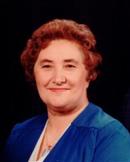 Margareta
Schanta, 93, of Whitehall, Pennsylvania, passed away June 22 in Lehigh Valley Hospital-Cedar
Crest. She was married to the late Emil Schanta. Margareta
Schanta, 93, of Whitehall, Pennsylvania, passed away June 22 in Lehigh Valley Hospital-Cedar
Crest. She was married to the late Emil Schanta.Born in Raabfidisch (Rábafüzes), Hungary, she was the daughter of the late Franz and Maria (Kroboth) Schanta. A member of the Amalgamated Garment Workers Union, she was a sewing machine operator at the former Cross Country Clothes in Egypt and Northampton, retiring in 1983. She was a member of St. Peter's Catholic Church, Coplay. She was a member of the Coplay Sängerbund and its chorus. Survivors: son, Emil Schanta and his wife Catherine of Whitehall; daughter, Margareta Schanta, at home; daughter-in-law, Anna Marie Schanta of Whitehall; 4 grandchildren; 6 great-grandchildren. She was preceded in death by a son, Franz and 13 brothers and sisters. Services: Mass of Christian Burial at 10:00 a.m., Friday, June 27, St. Peter's Catholic Church, Coplay. Viewing from 7 to 8:30 p.m. Thursday and 8:30-9:30 a.m. Friday, Robert A. Hauke Funeral Home (haukefuneralhome.com), 327 Chestnut St., Coplay. Interment, St. Peter's Catholic Cemetery, Whitehall Published in Morning Call on June 24, 2014. |
|||||||||||||||||||||||||
END OF NEWSLETTER |
|||||||||||||||||||||||||
NOTICE (Terms and Conditions): The Burgenland Bunch (BB) was formed and exists to assist Burgenland descendants in their research into their heritage and, toward that end, reserves the right to use any communication you have with us (email, letter, phone conversation, etc.) as part of our information exchange and educational research efforts. • If you do not want your communication to be used for this purpose, indicate that it is "confidential" and we will abide by that request. • Correspondents who communicate with the BB without requesting confidentiality retain their copyright but give a non-exclusive license to the BB allowing us to forward to BB members, publish in our monthly newsletter or on our website, and/or subsequently and permanently archive all or parts of such communications. The Burgenland Bunch homepage (website) can be found at: http://www.the-burgenland-bunch.org Burgenland Bunch Newsletter, copyright © 2014 by The Burgenland Bunch All rights reserved. Permission to copy excerpts granted if credit is provided. |
 News
News Attack
on Ancestry.com: Around midday on Monday, June 16, attackers targeted Ancestry
with a Distributed Denial of Service attack (DDoS). During the attack, Ancestry websites,
including Rootsweb, were clogged with massive amounts of bogus traffic that took the
sites down. Ancestry staff have since neutralized the DDoS attack and many of their
websites have been up since midday June 17 (though they warn that intermittent issues may occur
as they bring the sites back to full capacity and build defenses to mitigate future attacks). No
data was compromised by the attack.
Attack
on Ancestry.com: Around midday on Monday, June 16, attackers targeted Ancestry
with a Distributed Denial of Service attack (DDoS). During the attack, Ancestry websites,
including Rootsweb, were clogged with massive amounts of bogus traffic that took the
sites down. Ancestry staff have since neutralized the DDoS attack and many of their
websites have been up since midday June 17 (though they warn that intermittent issues may occur
as they bring the sites back to full capacity and build defenses to mitigate future attacks). No
data was compromised by the attack.  Update
on book "The Burgenländer Emigration to America": As I will do for a while, here is this
month's update on purchases of the English issue of the 3rd edition of Dr. Walter Dujmovits'
book “Die Amerika-Wanderung Der Burgenländer.”
Update
on book "The Burgenländer Emigration to America": As I will do for a while, here is this
month's update on purchases of the English issue of the 3rd edition of Dr. Walter Dujmovits'
book “Die Amerika-Wanderung Der Burgenländer.” 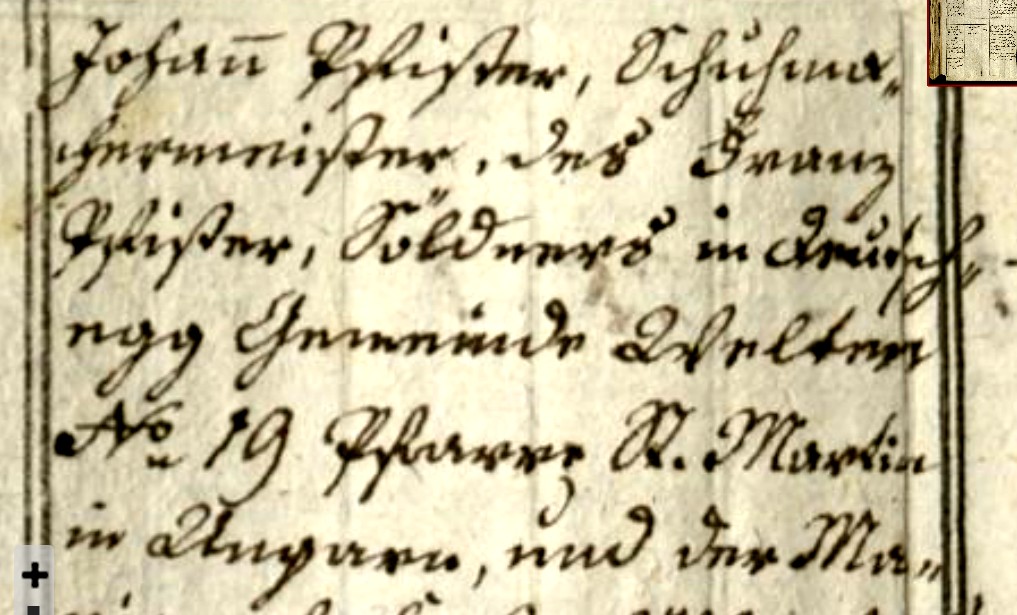 While
I could read most of this without too much difficulty, one word had me baffled... so I sent my
transcription to Fritz Königshofer for his opinion, with the word in red being the one in
question: “Johann Pfister, Schuhmachermeister, des Franz Pfister, Söldners in
Imuschegg Gemeinde Welten No.19 Pfarre St. Martin in Ungarn, …”.
While
I could read most of this without too much difficulty, one word had me baffled... so I sent my
transcription to Fritz Königshofer for his opinion, with the word in red being the one in
question: “Johann Pfister, Schuhmachermeister, des Franz Pfister, Söldners in
Imuschegg Gemeinde Welten No.19 Pfarre St. Martin in Ungarn, …”.
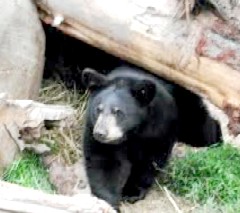 ►
A (blonde?) Burgenländer lies in the hospital with serious injuries. His visiting neighbor asks
him, "How did you do this?"
►
A (blonde?) Burgenländer lies in the hospital with serious injuries. His visiting neighbor asks
him, "How did you do this?"